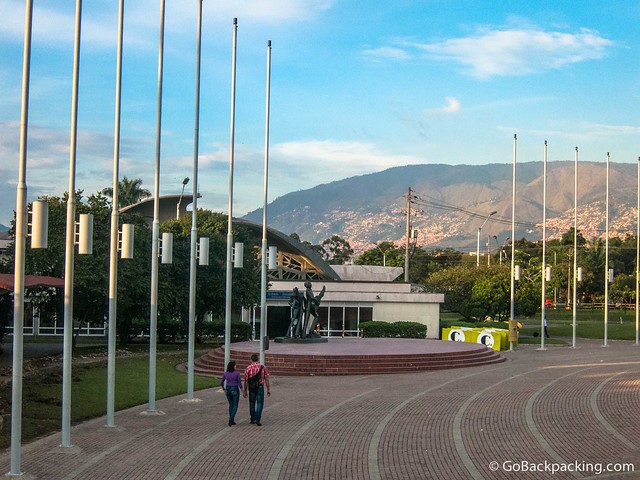
On the afternoon of June 24, 1935 Carlos Gardel, tango’s most popular singer/composer, was en route from Bogotá to Cali for a performance.
Upon landing at Olaya Herrera Airport, Gardel’s plane crashed into another on the ground, and all but three passengers on board perished.
As a result of Gardel’s death, Medellin was forever linked to the world of tango. Ironically, if the plane’s fuel tanks had been full when they departed Bogotá, they would’ve been able to fly direct to Cali, but as fate would have it, they weren’t.
The cause of the crash has been the subject of much debate. Popular theories include a weather disturbance at the airport, a rivalry between the pilots operating the two planes, and reports of an errant gunshot meant for Gardel, but hitting his pilot instead.
In order to further explore the history of tango in Medellin, I recently went on the Carlos Gardel Tour offered by ZORBA Travel.
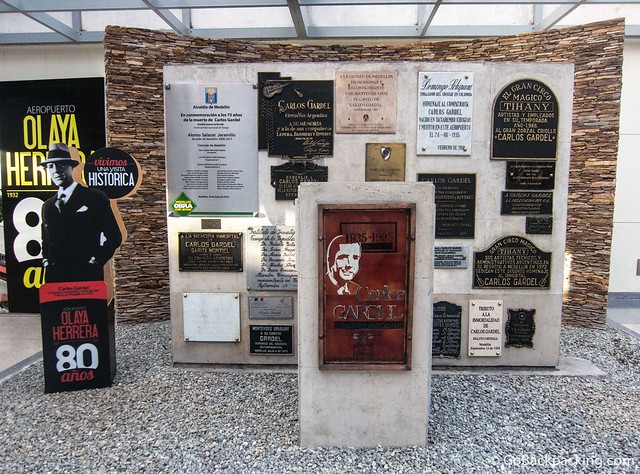
Plaza Gardel and Olaya Herrera Airport
At 5PM on a Saturday afternoon, Juan, my bilingual tour guide, picked me up in Ciudad del Rio. Our first stop was Plaza Gardel, located outside the Olaya Herrera Airport.
On November 4, 2003, the plaza was dedicated to Carlos Gardel. The focal point is a statue of a tango singer with a guitar, and a couple dancing. Plaza Gardel is used regularly to host open air events, such as musical performances.
Walk into the airport from the door facing Plaza Gardel, and you’ll see a collection of plaques and memorials to the singer.

Plaza Cisneros
Juan and I walked back to his car, as the sun was setting, and drove toward Centro. Along the way, we picked up his friend, a serious tango aficionado.
Together, the three of us drove first to Plaza Cisneros (aka Plaza de las Luces).
Juan pointed out the old train station across the street from the plaza, and explained that in the early 1900’s, Medellin was developing as an industrial hub within Colombia, and migrant workers were coming into the city from the surrounding countryside via train.
At the time, Plaza Cisneros was a big marketplace, filled with bars and prostitutes. It was exactly the kind of environment where workers liked to drink away their hard-earned money on the weekends.
In Buenos Aires, it was in similar immigrant ghettos that tango first developed.
Salon Malaga
From Plaza Cisneros, we headed to the nearby Salon Malaga. Established in 1957, it’s Medellin’s oldest milonga (tango bar).
As soon as we exited the car, I could hear live tango music. Juan mentioned that the area around Malaga was once similar to Plaza Cisneros, with lots of bars and prostitutes, making it popular with the migrant workers.
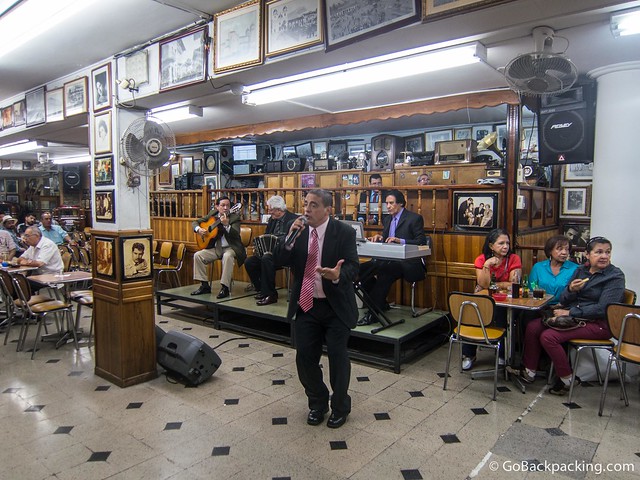
Located in the shadow of the San Antonio metro station, I’d never actually noticed Salon Malaga before. Yet here we were, stepping back in history.
It was hardly 7PM, but the bar already had its share of patrons, complete with tables reserved for those arriving later.
We walked past the tango singer, and walls plastered with old photos and tango memorabilia, toward the back of the bar. I ordered a beer, and later, bought an Argentine-style empanada offered from a basket by two men in black shirts and aprons.
After 30 minutes of listening to the music, and taking in the atmosphere, we left for the next stop on the Carlos Gardel Tour.
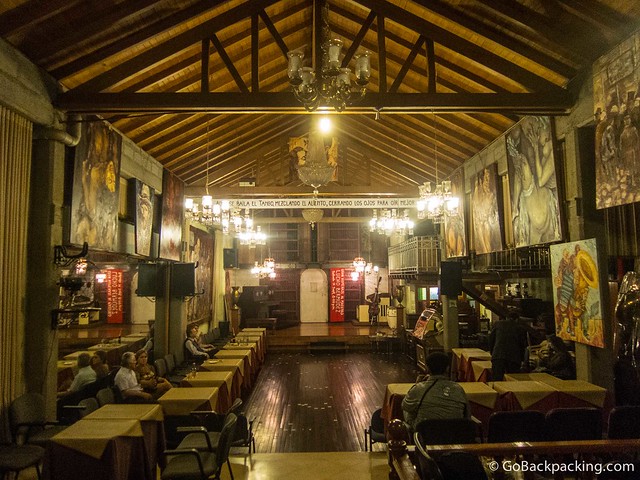
Dance Lesson at Escuela Mayor de Tango
From Centro, we began driving west, and up the mountains toward Robledo, a working class district of Medellin I’d never visited.
Our destination was Escuela Mayor de Tango (Carrera 80 #77BB-02, Barrio La Pilarica), run by Jose Gabriel Alvarez and his wife.
Upon arrival, there was a politician using the space to talk with residents. We waited patiently for that event to wrap up, and then entered the milonga.
The walls were covered in Jose’s paintings, depicting tango scenes as well as famous works by Vincent Van Gogh. Juan informed me Jose had also previously worked as an architect.
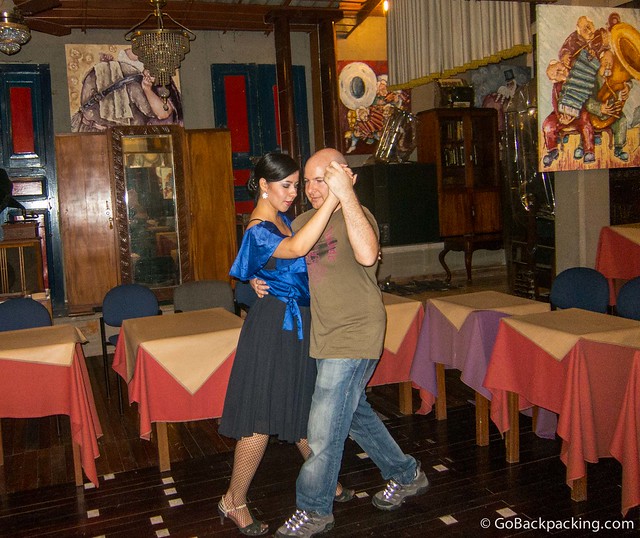
It was here that I would partake in a private tango lesson by Jose’s wife.
I was feeling a little rusty, and concerned that I’d forgotten everything I learned from my four private lessons in Buenos Aires last year.
To my surprise, I began remember the basics, and during the hour of practice, I also learned a new move.
Meanwhile, regular patrons began to arrive for a night of tango dancing.

Dinner Show at Patio del Tango
Our last stop of the night was a familiar one, Patio del Tango in Barrio Antioquia. We arrived at 9:30PM, and the entertainment was already under way.
Before we took a table, Juan pointed out a poster in the back of the restaurant, featuring old black and white photos from Carlos Gardel’s life, and the plane crash in Medellin.
There was even a photo of what was purported to be Gardel’s corpse (something I didn’t need to see before sitting down to eat).
As for dinner, I opted for the chicken with chimichurri sauce (not included in the price of the tour). A little after 10PM, after watching several dance performances and wrapping up dinner, Juan dropped me off back at my building.
There’s more to Medellin than salsa and reggaeton. Whether you’re a tango aficionado, or simply looking to do something different, I highly recommend the Carlos Gardel Tour.
It runs on Thursday, Friday and Saturday nights at 5PM, and lasts 5 hours. Pick up and drop off from your hotel is included, as is a bilingual guide. For more info, and prices, check out ZORBA Travel.
________
My Carlos Gardel Tour with ZORBA was provided at no cost, in order to experience and write about it here.

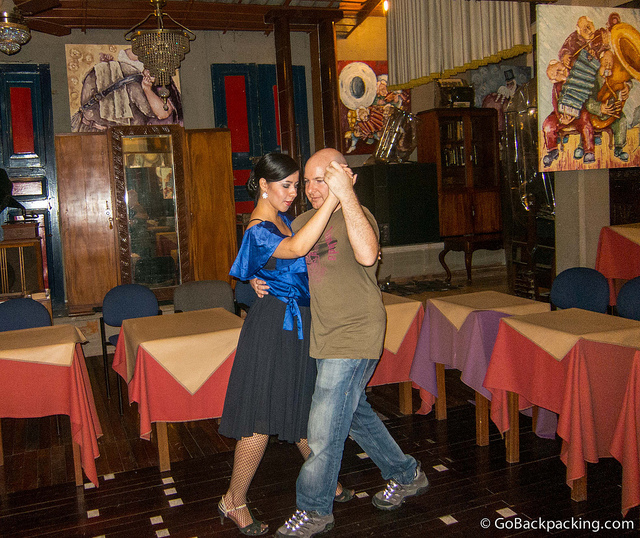

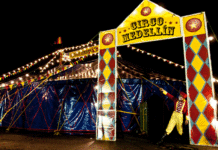


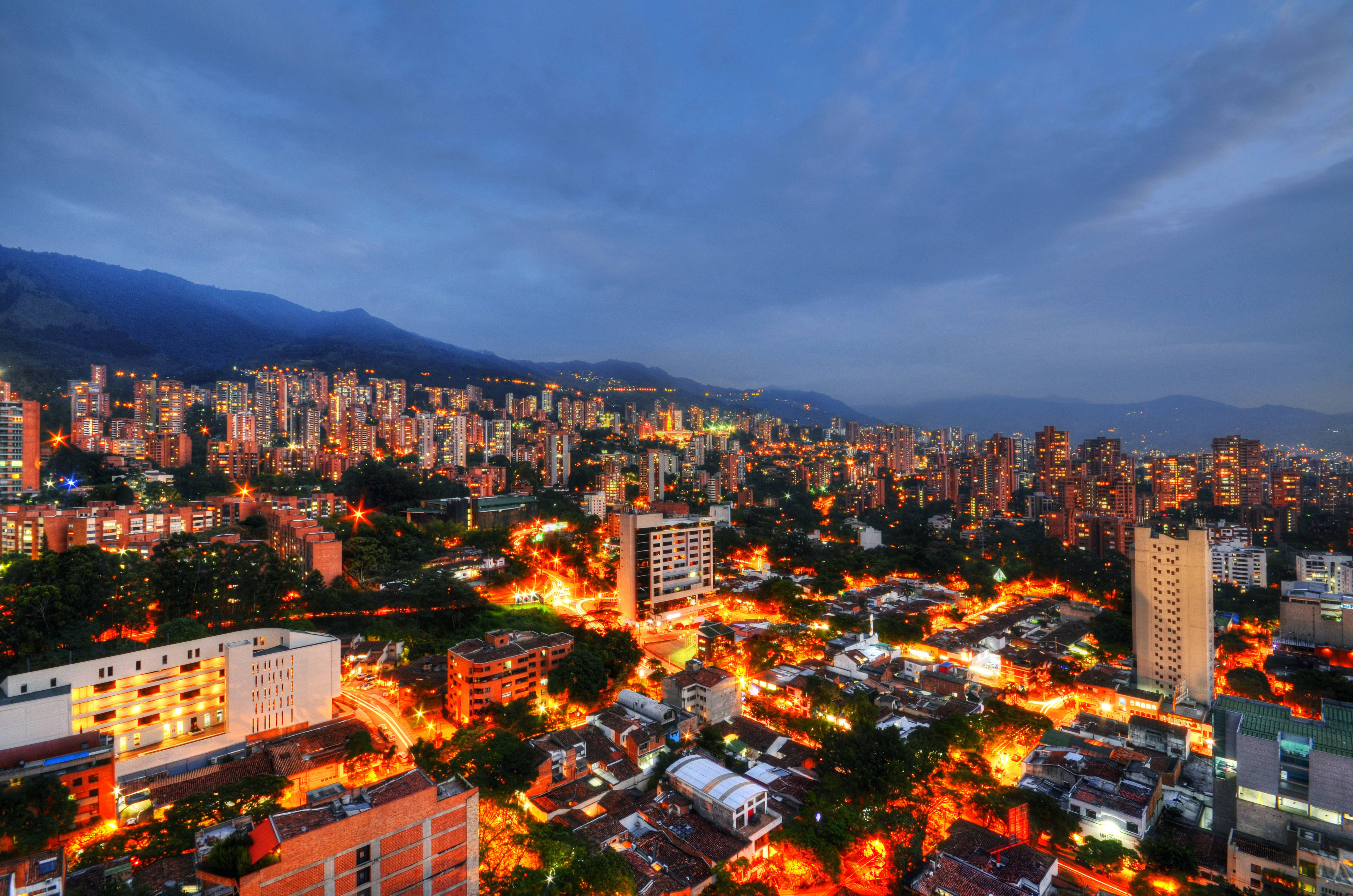






$131 for a 1 person tour is very expensive, taking into account it’s a very easy tour to do by yourself.
Hi Juan, I’d agree it’s expensive if you’re doing it solo as a private tour. The more cost-effective approach is to get a group of 4 people together, which brings the price down to $223 total, or $56 per person.
I believe that’s very fair for what you get. I was paying $50/hour for private tango classes in Buenos Aires, so that part alone adds a lot of value.
I’d previously been to several places on the tour, but what I was more interested in was the history of tango in Medellin, and you won’t learn that just by visiting the sites on your own. Juan, the guide, filled in a lot of blanks for me.